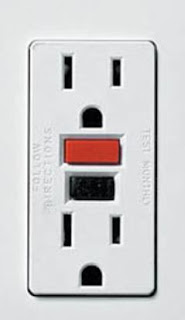GFCI Inspections


Many inspectors use a plug in device to “test” GFCI receptacles. Although these devices may work on older GFCI receptacles, they may not trip a newer GFCI receptacle. I have seen many times a GFCI tester not trip an ungrounded GFCI receptacle. GFCI’s monitor the current between the hot and neutral; not the ground. Although, an ungrounded circuit with a GFCI receptacle will provide some protection, it is always best to have a GFCI connected to a grounded circuit.
Newer GFCI’s can be identified by a status indicator light. They perform self tests and are designed to meet the latest UL standard for auto-monitoring (self-test). Newer GFCIs periodically conduct an automatic internal test to confirm that it can respond to a ground fault. If the test button is pressed on a newer GFCI it will prevent reset of the GFCI if it is not wired or operating correctly. Because of this most of the states and national standards for testing GFCI receptacles and circuit breakers advise the inspector to press the “test” & “reset” buttons in that order. If the status indicator light goes on (newer GFCI’s) and the unit resets, then the device is wired and functioning properly. On an older device, be sure to check and ensure power has been restored. Always recommend a licensed electrician properly ground all circuits. So how should a home inspector test, evaluate, and advise their clients regarding GFCI’s;
Testing an older GFCI (without a status indicator light):
- Older GFCI’s can still be tested with a plug in device, however if the receptacle is not grounded, it may not trip the receptacle.
- If there is not a ground, recommend a licensed electrician upgrade. (trips or not with tester)
- If a ground is detected, your testing device should trip the test button (satisfactorily responded)
- If a ground is noted and the tester does not trip the test button; recommend it is evaluated by a licensed electrician. Although grounded, the “line” and “load” connections or branch circuit wiring may be incorrect.
- The receptacle itself could be also faulty
- There could also be an issue with the circuit or over current protection device
- It may be prudent to have the electrician upgrade the GFCI to a newer self testing receptacle
- These devices are meant to protect against electrocution; therefore, we should not indicate they are safe unless grounded and respond to our testing device.
Testing a newer GFCI (with a status indicator light):
- If you see a green status indicator light; this will indicate that the receptacle is wired & working properly. TO TEST:
- Press the “test” button, the receptacle should trip & the status light should go off. You can also verify this with a mechanical tester
- After the receptacle is tripped, pressing the reset button should cause the status indicator light on the receptacle to come on (green). This indicates that the receptacle is wired and functioning properly. This is an acceptable method to test newer GFCI’s.
- If a ground is not detected (which would be unlikely, but possible) with the mechanical tester, recommend a licensed electrician upgrade, even if it responds to the test button.
- A determination should not be made on the GFCI’s status with a mechanical tester because it may not trip the test button.
- Most home inspection standards of practice require pushing the test button to ensure the power is turned off. This can be verified by the mechanical tester or the status light going off.
- Be sure to press the reset button and verify the status light comes back on. If it does not, the receptacle may be defective or there is a problem with the circuit. Recommend repair by a licensed electrician.
- Newer GFCI’s periodically conduct an automatic internal test to confirm that it can respond to a ground fault
- A red status indicator signifies the following:
- Red blinking = initial self test (initial power up only)
- Red solid or blinking = press test / reset to reset GFCI
- If red status light does not go off = device / wiring faulty
Related Articles:
- Inspecting Exterior Electric Components
- Fused Neutrals
- ARC Fault Circuit Protection Part – 2
- ARC Fault Circuit Protection Part – 1
Want To Learn More? Click HERE to Search Our Full Database Of Home Inspector Newsletters.



